|
The angelfish, Pterophyllum scalare, were imported
approximately 75 years ago (about 1920) bound for aquariums.
It was considered during many years difficult to raise,
which is not any more the case today. Pterophyllum altum
remains on the other hand in this respect a challenge for
the amateur. There are certainly already reports on the
artificial breeding of the young, but this may be the first
time that a natural method is described. "
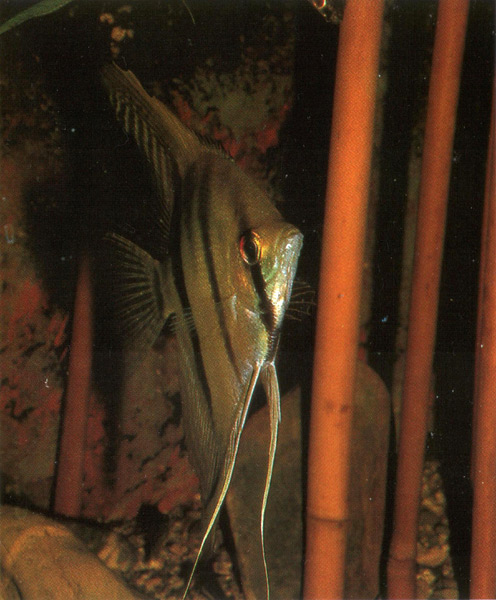
Pterophyllum altum out of aquarium.
|
| Pterophyllum altum out of aquarium. |
I have devoted myself for 19 years to the discus. Since 7
years, I also maintained Pterophyllum altum. During my
preceding experiments, young wild specimens reached in a one
year's time, a 25 centimeters height. I was however,
confronted each time at the same failure: all these fish
died in a completely unexpected way.
The stress and panic were each time the cause. An animal
was frightened, left in an access terror through the
aquarium to knock itself in the panes and the roots
constituting the decoration. In the one moment space, all
the other individuals had the same reaction. After 5 or 10
minutes, they succumbed to the wounds, which they had
inflicted themselves. These tragic events caused me many
nights without sleep.
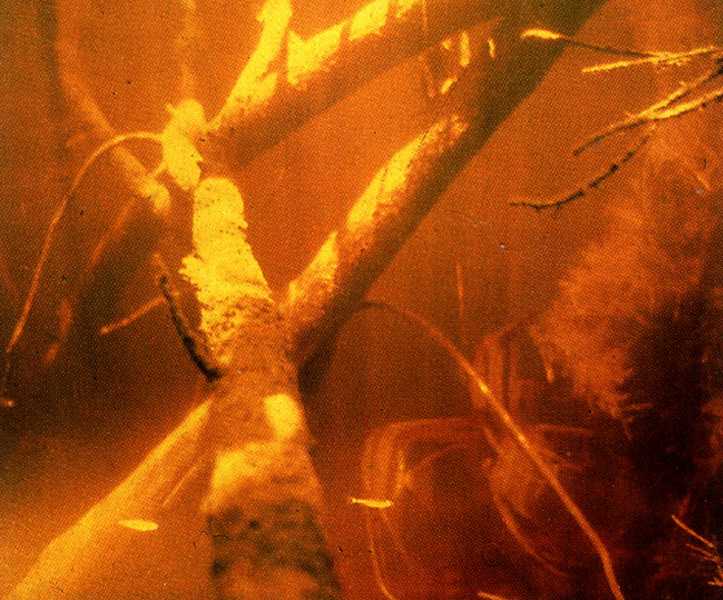
In the black water of Canó San Joaquim, among the immersed trees, Alf Stalsberg captures a glimpse of the Pterophyllum altum in his natural environment.
|
| In the black water of Canó San Joaquim, among the immersed trees, Alf Stalsberg captures a glimpse of the Pterophyllum altum in his natural environment. |
With four other Norwegian and Danish aquarists, I
undertook, from February to March 1991, a voyage in
Colombia. During this voyage, we went to the Rio Inirida and Rio
Atabapo. It is in Rio Atabapo, which marks the border
between Colombia and Venezuela and which is emptied later
into the Rio Orinoco, that Chaffanjon discovered the first
angelfish. This one was described in 1903 by Pellegrin, and
named Pterophyllum altum.
We noted the characteristics of water, the details on the
vegetation and the medium of origin of Pterophyllum altum.
During the rainy season, the area is covered by water. It
then forms the natural spawning grounds of the altum
angelfish. We thus examined this biotope in a very attentive
way, in the search of data transposable to the aquarium and
which could possibly appear paramount for maintenance. Our
voyage proceeded during the dry season, the rivers thus had
a relatively low flow.
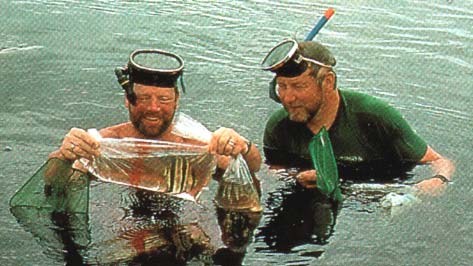
Danish Erik L and Norwegian Alf Stalsberg with a Pterophyllum altum coldly captured near rock banks of Rio Atabapo.
|
| Danish Erik L and Norwegian Alf Stalsberg with a Pterophyllum altum coldly captured near rock banks of Rio Atabapo. |
We learned that during the rain season, the level of Rio
Inirida goes up 8 meters. We tried to record the subaqueous
landscape such as it must be during this season. It was not
easy because 8 meters of water on a vast surface offer to
fish considerable spaces in which they profit from
innumerable possibilities of choice of territories and sites
of reproduction. This exercise was even more difficult on
Rio Atabapo. This one runs indeed in a plain, which during
the rain season is transformed into a giant lake. The
physicochemical characteristics of the water of Rio Inirida
and Rio Atabapo, measured on the spot, were: pH 4.8;
conductivity 15 µS; total hardness 0°. All carbonated
hardness 0°. All nitrites 0 mg/L and temperature 30-32 °C!
We unfortunately could not learn the values taken by these
parameters during the rain season.
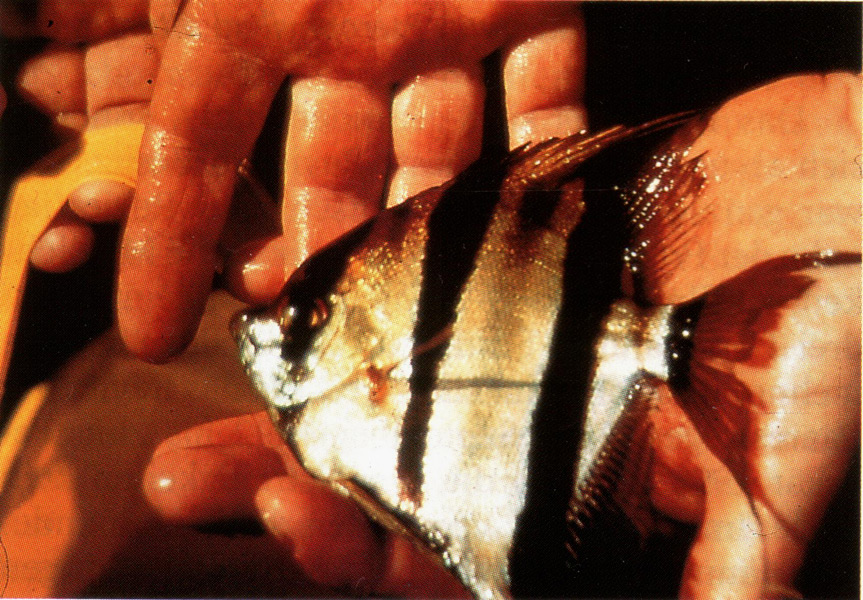
Pterophyllum altum of black water of rock banks of Rio Atabapo.
|
| Pterophyllum altum of black water of rock banks of Rio Atabapo. |
In Rio Atabapo and Canó San Joaquim, an affluent of Rio
Inirida, we found Pterophyllum altum. In addition to the
specimens captured by our care, we also bought young
individuals with obliging Indians, at the price of
approximately 40 pfennigs. But with our great regret, it was
impossible for us to take along any fish with us. We thus
left them with the care of an exporter, in Bogota, while we
traverse other parts of the country. With our return, the
director of this establishment told us that all the animals
had died...
In November 1991, I bought in Stockholm some young 10 cm
height, wild specimens. They were in very bad health. Their
state was extremely alarming. They had probably not received
food for a long time or had refused it for an unspecified
reason. I placed at their disposal an aquarium of 700 liters
dimensions 100x100x70 (LxlxH). In this aquarium,
Pterophyllum altum were in company of 7 young turquoise
discus. The bad health of the angelfish mentioned above, had
as a consequence, that in the one week's time, two of them
died. The five survivors had however started to eat,
initially with hesitation. As I live only a few minutes from
the sea, I can almost daily nourish my fish with live Mysis.
Thanks to these delights and to others, the Pterophyllum
altum came back quickly. In one year, they grew almost 20
centimeters in height and still today, with my great joy,
they enjoy an excellent health.
The maintenance of Pterophyllum altum succeeded while
following the "discus method ."
The aquarium was filled with tap water of a conductivity
of 300 µS approximately and of a pH close to 7. The
temperature averaged 29-30°C. In addition to the Mysis
mentioned above, and of which I freeze a part, the food is
made up some various species of mosquito larva and a "house"
preparation containing heart of ox, spinach and of alga
powder. Pterophyllum altum readily accepted this "
traditional " food for discus. At the beginning, they
however did not show any desire for it. On the other hand,
they ate with great appetite on the particles of food
suspended by the discus. After some time, they ended up
being also nourished by them on the bottom of the aquarium.
The decoration of the aquarium consisted of roots, which I
had laid out in such a way that two territories separated by
a " strategic " delimitation were thus created. For reasons
of hygiene, the aquarium did not comprise of gravel or soil.
I practiced this method already for many years. It seems the
angelfish accepted this installation very quickly, because
of the fights of dominance and for territories that took
place.
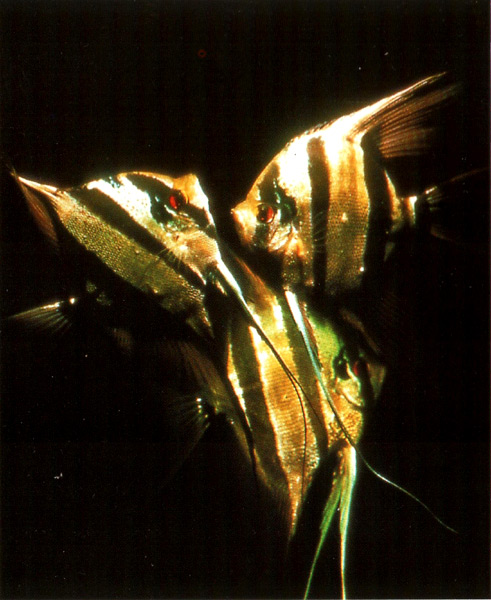
Males Pterophyllum altum in full combat.
|
| Males Pterophyllum altum in full combat. |
In September 1992, I was convinced that a couple had been
formed, and that among the other animals were a female and
two males. The couple, which had been formed, isolated and
took possession of the best territory, which was exactly
what I wished. This territory was indeed close to the front
pane and this gave me the chance of filming and of
photographing with leisure. The three others altums settled
in a well defined territory, more or less forming a
half-circle around that of the couple.
From September 1992 to February 1993, the territorial
combat did not cease. The two other males continuously tried
to enter into the territory of the couple and to obtain the
favors of the female. Although it seemed sometimes that they
had succeeded, the two applicants ended up failing. During
this period, I distributed especially white larvae of
mosquitoes. The altum angelfish truly overflowed with energy
and showed an enormous vitality.
In March 1993, I replaced tap water with de-mineralized
water with a conductivity of 10 µS by means of continuous
water changes and also started to filter on peat. My
intention was to prepare Pterophyllum altum for a spawning
in April or May. It is indeed during these months that, in
nature, the altums reproduce. Moreover, for this period, I
have access to almost unlimited quantities of live food. The
black larvae of mosquitoes in particular, which are
generally considered on our premises the best of foods, are
then indeed available in enormous quantities.
Then at a glance, Pterophyllum altum offered a beautiful
image to observers: their body was extended to the extreme,
their dorsal and their anal fin shone of an intense dark
red. They were held face to face, being provocative and
being impressed mutually. These engagements did not want to
cease. Slowly at home, the impression was reinforced that
the couple would not lay with the three other individuals in
the aquarium. I had then already withdrawn the discus of the
aquarium for several months. I could not, however determine
if I had too many Pterophyllum altum in the aquarium. We
knew indeed that the presence of " hostile " fish stimulates
the instinct of care and the behavior of defense of the
offspring at the reproducers.
We were now in mid-May. The period of breeding reached
it's end. I thus decided finally to withdraw the three other
altum, but at the end of one week, nothing had occurred. I
would have given a lot of money for good consultation. What
was I to do? I did not have any intention to put the other
altums with the couple. There had to exist a means of
starting the laying. I knew it, but which?
A reproductive couple of discus, which laid three days
after its introduction into the aquarium showed them the "
procedure ".
The water of the aquarium had from this point, a
conductivity of 30 µS and a pH near 5. A few days after the
discus layed, the couple of angelfish started to clean "
it's " root. I placed a large foot of Spathiphyllum in the
vicinity in order to offer an alternative to them. The
couple could indeed prefer with the root another substrate
for laying. The plant was inspected with great interest and
immediately cleaned at once.
We were now at Pentecost. As of the hatching of the
discus eggs, the parents transported the larvae towards the
root of the angelfish. It was an error on their part. The
couple of angelfish jumped on the occasion and had a true
feast. I removed the discus, then Pentecost passed. They had
still not layed, even if the activities of cleaning
intensified.

Les larvae of Pterophyllum altum fixed on a sheet of Spathiphyllum are supervised by the female.
|
| Les larvae of Pterophyllum altum fixed on a sheet of Spathiphyllum are supervised by the female. |
June 1, I had left all the day and returned at home
towards 18:30. My first glance, naturally, was as usual for
my angelfish. I couldn't believe my eyes: the couple was
depositing its eggs meticulously and did not allow
themselves to be disturbed by my presence. Stuck on the
root, ordered extraordinarily well in chains, already
approximately 150 eggs were there. I set up my video camera
and I held ready near the aquarium and then filmed with
desire. I succeeded in getting some good sequences. The
attempt to illustrate the laying by slides failed because of
my flash. This one broke down unfortunately precisely at
this time. At 23:00 hours, the laying ended; the result
reached approximately 600 eggs. The female dealt with the
care of guarding the laying while the male posted itself at
some distance. I remained awake most of the night. Would the
laying be still present at the morning? Would complications
emerge between the two parents? I rose very impatient, but
my fears appeared unfounded. The couple dealt with the care
with the laying in the most perfect harmony and only some
eggs had bleached.
Thereafter, approximately a third of the laying mildewed
and was withdrawn by the parents. According to my
experiment, the rate of hatching is increasingly weaker when
the laying takes place on a root than on, for example, a
spawning cone for discus. For this reason, I would like to
reconsider the nature of the substrate of laying. In the
mass and the cracks of a root probably always remain
micro-organisms which cannot be reached by cleaning fish. It
is a factor, which to a certain extent, can harm a laying
deposited on a root.
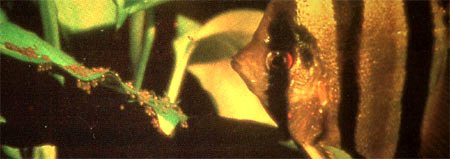
In the morning of the seventh day after the laying, the parents swam in a dense cloud of several hundreds of fry (alevins).
|
| In the morning of the seventh day after the laying, the parents swam in a dense cloud of several hundreds d?alevins. |
With a temperature of 30°C, the larvae emerged after 60
hours.
The larvae were immediately transported towards a leaf of
Spathiphyllum under the vigilant guard of the parents. 72
hours later, the first larvae started moving and to leave
the leaf to undertake, in a still awkward way, their first
movements of freeswimming. These attempts were prevented by
the parents. The fugitive ones were immediately caught up
with in the mouth of their parents and at once replaced on
the leaf. It ran another 72 hours before the alevins all
reached freeswimming. During last 24 hours, the parents were
unceasingly occupied catching the fugitive ones and to
replacing them with the others, an almost impossible task.
Each time that an fry (alevin) is brought back to the nest,
there were still two or three others, which were to flee.
But the couple achieves its duty in an impressive way. By
perfect team work and no rest, all the young escaped
prisoners were brought back. The couple astonished me
considerably. They instinctively behaved with the experience
which one meets only with couples having already raised
several batches.
In the morning of the seventh day after the laying, the
parents swam in a dense cloud of several hundreds of
alevins. It was impossible to count the alevins. I estimated
their number at approximately 300. I naturally had on hand
the newly hatched nauplii of artémia and immediately started
to nourish the young. It was however still too early. The
fry still fed from the remainder of their yolksac reserve.
It is only in the middle of the day that they accepted the
first Artemia nauplii.
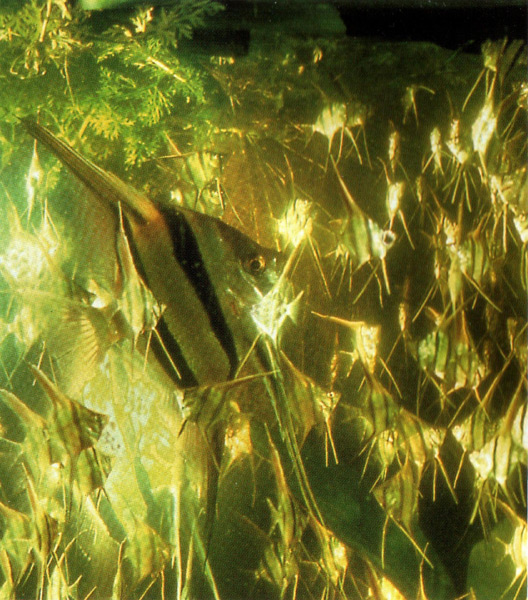
Pterophyllum altum with its 10 weeks old young people.
|
| Pterophyllum altum with its 10 weeks old young people. |
Nine months had passed since the first time I had a
prediction that a natural reproduction could be possible.
For this period, the problems and the reflections were
numerous. But finally, all was held without encumbers and
much more simply than I had imagined it. The development of
fry (alevins) was spectacular. They showed a good appetite
and their growth was extraordinarily fast. The parents
supervised their offspring with a very great attention. When
I approached the aquarium to nourish them or that I showed
myself too importunate, one of the two parents immediately
sounded alarm by abrupt quiverings of the body while
advancing, threatening, towards the frontal pane.
The fry (alevins) developed quickly and without problem.
I obtained only five fry (alevins) with the abnormal belly
and one with the dorsal fins and anal deformities. It is a
result, which taking into account the great number of young,
is almost negligible. During their growth, I lost only 3
young. The first died after 24 days and had a 26 mm length;
the second after 38 days and had a 35 mm length and a 55 mm
height; the third after 56 days was 55 mm long and 85 mm in
height.

The 10 weeks old young people present already the silhouette characteristic of the adults.
|
| The 10 weeks old young people present already the silhouette characteristic of the adults. |
The breeding of the young people was very simple. Each
day, I changed part of water and cleaned the excrements
deposited at the bottom of the aquarium. No remainder of
food remained a long time in the vat! After one month, I
started to make the water changes with tap water. At the
time when I wrote this article, four months had passed since
the laying. I placed the couple with 15 young in an aquarium
of 450 liters. Still now, after four months, the parents
conscientiously continue to look after and defend their
offspring, even though when first placed in their new
premises, the first tendencies appeared to be to give up
their responsibilities. Their fins shine again of this
intense dark red. Might be they will soon again start to
lay! |